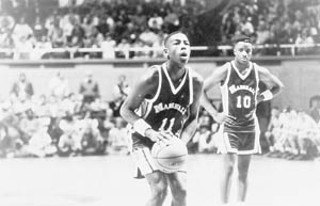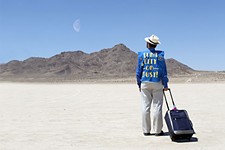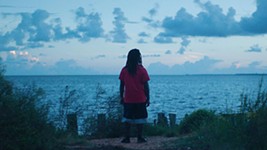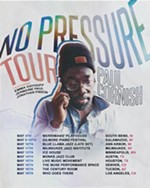On the Line, Two Shots
The Texas Documentary Tour: Steve James' 'Hoop Dreams'
By Anne S. Lewis, Fri., April 7, 2006

Halfway through the seven-year making of Hoop Dreams, director Steve James, as all doc-makers must, was desperately beating the bushes for more funding. A prospective major donor, the MacArthur Foundation, which would subsequently come in with some big bucks, asked whether there was any chance that the three-hour videotape documentary, spanning five years in the Dickensian life and career twists of two talented black high school basketball players, might ever find its way into a neighborhood multiplex – would it ever get, you know, theatrical distribution?
James quickly put the kibosh on that one; the film was about hoop dreams, not pipe dreams. In those days, documentary, with few exceptions of the Michael Moore ilk, had yet to shed its medicinal/good-for-you mantle; its customary theatrical outlet, to the extent there was one, was the arthouse. And the arthouse crowd was never known for its interest in sports. At that point, James recalls, the highest aspirations he and partners Peter Gilbert and Frederick Marx had were that PBS would accept the film and give it a decent slot: "anything but 10pm on a Monday night."
Here's how things went down: Following a triumph at Sundance, the film essentially went straight to, you know, theatrical distribution, where, with a box office of $8 million, it became the highest grossing documentary of its time. Not too shabby for 1994.
The film famously broke ground by following the fortunes of two inner-city Chicago 14-year-olds, William Gates and Arthur Agee, from the time a scout for a suburban high school – the same basketball powerhouse where former inner-city kid Isaiah Thomas got his start – recruits them at a neighborhood pick-up game, through their high school years and into college. The novelistic drama and pathos the filmmakers captured on 250 hours of footage – the bumpy trajectory of two families' lives, so aptly described as the "script from God" – took 21/2 years to edit. The result, even at three hours, was an incredibly lean "montage" of telling moments, distilling the essence of what happens when two innocents and their hoop dreams are invited onto the court for an against-all-odds shot at stardom.
It all began with a 90-minute daily commute from home to St. Joseph's, the mostly white Catholic high school that recruited them. At home were permanently (abandonment) or intermittently (drugs, prison, redemption) absent dads and moms struggling to keep the family fed and the lights on with minimal welfare checks. In his sophomore year, there would be a girlfriend and a baby for 16-year-old William. At school was the ongoing struggle to stay afloat academically and earn the financial assistance extended by fulfilling the on-court expectations that got you there in the first place. Arthur fell from grace when he lost ground on both fronts and then defaulted on even the reduced tuition payments. He goes back to where he came from. (St. Joe's will later hold his family to their tuition debt.) His game subsequently soars, and, in his senior year, Arthur leads his team to the state finals. He gets recruited by a junior college in Missouri and later by Arkansas State. William fares better academically at St. Joe's, has a corporate financial benefactor, and exceeds expectations on the court – until sidelined by a serious knee injury that'll diminish his game and confidence, henceforth. He gets recruited by Marquette University, graduates with a degree in communications, and is now a pastor. Neither of boys ended up in the NBA.
The film, on the other hand, would end up as the 1994 New York Film Festival's concluding film, a prestigious placement never before occupied by a documentary. The filmmakers watched the film with the Agee and Gates families (and an audience of 2,500) from opera boxes at Alice Tully Hall. There was a brouhaha when Hoop Dreams failed to get an Oscar nomination for best documentary. St. Joe's high school, unhappy with the way it was portrayed in the film, sued for defamation. (The suit subsequently settled.) Even with the camera turned off, the lives of the two boys, now men, would continue to unfold in the most dramatic and filmworthy of ways.
Austin Chronicle: Four-and-a-half years of following these two boys, with 250 hours of footage, is a long time to have your camera at the ready, waiting for something to happen, and yet, this film captures a lot of dramatic, decisive moments. How did you know when something cameraworthy was going to happen?
Steve James: I've rarely had subjects in any of my films let me know in advance that something is happening. The kinds of subjects we've dealt with are not film-savvy, they're not reality-TV stars, they're just living their lives – which is part of their appeal, so it becomes incumbent upon us as filmmakers to check in with them. There were times when Arthur's family didn't have a phone, which meant we had to stop by – usually at least once a week – which was a pain in the butt to a certain extent, but, because it's always better to talk to them in person than on the phone, that turned out to be a positive thing. Also, not always having the camera with us every time we stopped by was also a good thing, though sometimes frustrating, because there were times we wished we could have been filming. But when you just stop in and talk, you gain a lot in terms of a family's or subject's trust when you're not just always there with a camera.

AC: Aside from funding, which is always a big challenge, what was the toughest part of the process?
SJ: How to edit the movie into a coherent story. When you watch the film, the story and the way we go back and forth may seem obvious, but, maybe because we weren't that smart, it took us awhile to get a structure for the film that really worked. We had to figure out things, like how much time do we spend with Arthur or William, one scene or more? We had all this material and had to find the story and find the structure that worked for both stories. In early efforts, we tended to bounce back and forth between the boys, it was more like ping-pong and made it hard to develop any kind of narrative momentum and still zero in and feel connected. When we discovered that was not working, the question became how to structure it so that the viewer got engaged by each story but didn't feel too far from the other story for too long.
AC: When you're involved with a family for a long period of time like you were in this film – when, for example, you paid an electricity bill when one of the families couldn't and their power was turned off – do you feel like your involvement with them – or protectiveness of them – might color the film you're making? Or that you might pull a punch or two, as far as what you include, or leave out of the film? Do you worry about things like that?
SJ: Yeah, the hardest part of doing this kind of work is when you become intimate with the families, and they become more than just subjects to you. You have strong feelings and often conflicting feelings about what happens to them. Part of you sees what tragic things befall them and feel[s] terrible. When William blew out his knee and the doctor thought it might be ligament damage, which could possibly end his career, that was a terrible feeling. But, as a filmmaker, you know that this is incredibly powerful and dramatic – so, that's a contradiction you struggle with. It's the hardest part of doing these kinds of films. But we also don't think of ourselves as journalists, we think of ourselves as storytellers, and I do think there's a distinction there. We're trying to tell true stories and get at a larger truth, but if that means that there are certain things that we don't put into the movie – like we did with Hoop Dreams, things we left out at the behest of the family that we felt were fair and reasonable – that's part of what makes the family trust you. We're not just there like reality TV, you know, where it's, 'If you say it, man, we've got it.' They feel like they have some control and feel like we're there to tell their story sympathetically and honestly, not there to tell everything that happens. And you have to balance that and walk that line. Different filmmakers have different standards about that and walk different lines. In a later film, Stevie, I try to grapple with those issues of exploitation and my role as both filmmaker and Big Brother and how to reconcile both those roles in the process of telling a very tragic story, more tragic and sad than Hoop Dreams.
AC: In the end, what are we to take away from watching four years of William and Arthur shooting for the big time?
SJ: The last thing we wanted the film to be was a diatribe against the Dream or about the futility of the Dream and the business of sports. That's all in the film, but I think it's better, because it shows why the Dream is so appealing and attractive and what these kids get from it emotionally, psychologically, and practically. Both these kids were able to get college scholarships. People have said they went back and forth, during the movie, trying to decide whether this basketball dream was good or bad for these kids. I thought that was great, because that's the way it's really experienced by these kids and their families. We didn't go in with the goal of cutting down the exploitation of kids by the business of basketball, even though that's one thing that's very much present in the movie. But given that we all played basketball, that would have been too simpleminded and dishonest for us. After all, how could we do that and then go home and get all excited about watching March Madness? ![]()
Alamo Drafthouse Downtown
Wednesday, April 12, 6:30pm
Steve James will be in attendance
Admission: www.austinfilm.org










